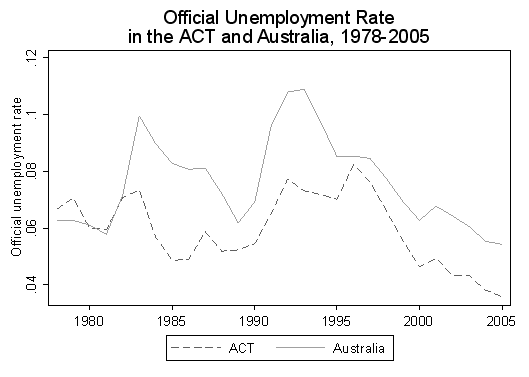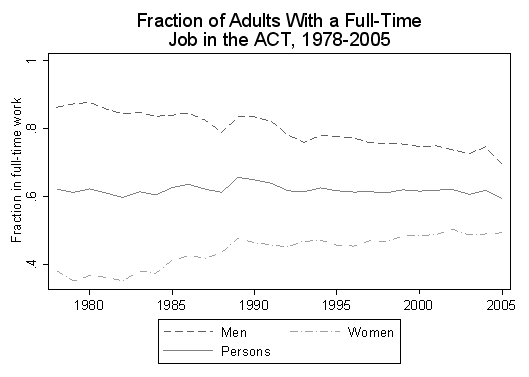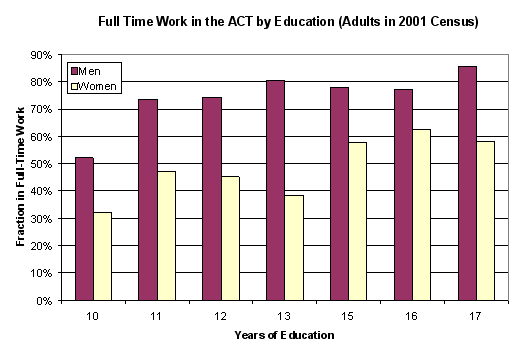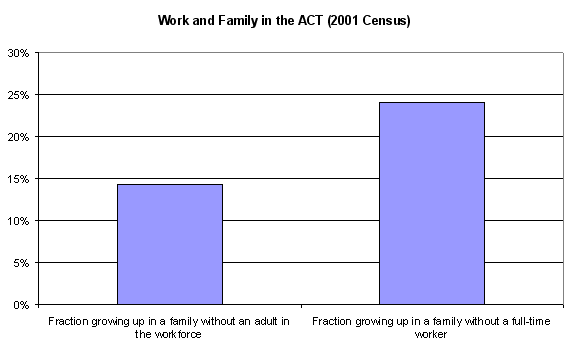Canberrans pride ourselves in our low official unemployment rate. Today, our headline unemployment rate is below 4 per cent, lower than it has been at any point in the past quarter of a century, and better than any other state or territory in Australia. In this environment, policy attention has shifted away from finding enough jobs, and towards the issue of skills shortages. Yet while it is true that skills shortages exist in particular areas, it would be wrong to assume that the issue of joblessness should be taken off the policy agenda. For while some skilled workers are in high demand, many unskilled workers in Canberra remain without a job.
In this debate, it is important to recognise that unemployment is not the only measure of jobs. The unemployment rate measures only those who are looking for work. Those who have given up looking, and many of those who are reliant on income support, are not counted as unemployed. And for major groups in the population, the fraction of those in work has been steadily falling.

Advertisement
To benchmark the ACT economy’s job-finding performance, a better measure than the unemployment rate is the share of adults in employment. On this figure, the proportion of adults (aged 25-64) with a full-time job has declined slightly since 1978. Today, only about 60 per cent of adults in the ACT have a full-time job. These trends are also true across Australia as a whole. (Paul Frijters and Bob Gregory, 2005, “From Golden Age to Golden Age: Australia’s ‘Great Leap Forward’?”).
Perhaps more troublingly, the average for adults has masked two major trends. Although women’s labour force participation has risen, the fraction of men with a full-time job has fallen. In the late-1970s, nine in ten Canberra men had a full-time job. Now, the figure is just seven in ten. Many of those who have dropped out of the labour force have moved on to income support, including the rapidly-growing Disability Support Pension.

The gap in full-time work is larger still if we look at the employment rates by education. For men with a university degree (15 or more years of education), employment rates are around 80 per cent. But for a man with a year 10 education, employment rates are only around 50 per cent. The same pattern is true for women: about 60 per cent of highly-skilled women have a job, compared with only about 30 per cent of low-skilled women.
The challenge for the ACT is clear: real jobs creation must be focused on those with least education. On a per-person basis, no state or territory in Australia is richer than the ACT. Yet among Canberra men with a year 10 education, half do not have a full-time job. Among Canberra women with a year 10 education, two-thirds do not have a full-time job. We can afford to do better than this.

Advertisement
Why does it matter if employment rates have fallen? The best reason to worry about employment rates is for the sake of children growing up in workless households. From careful research, we know that children do better in households with at least one parent in the labour force. Even apart from the extra income that comes from parental employment, the experience of growing up in an environment where parents prepare for work every day is more likely to prepare children for the world of work themselves. Otherwise, joblessness may persist across generations.
Yet in the ACT today, one in six children lives in a household where no adult has a job of any type, and nearly one in four lives in a household where no adult has a full-time job. If this pattern persists, there is a risk that children who grow up in workless households will themselves be less likely to find a job in the future.

What might the ACT government do about this? With its latest package of welfare reforms, the federal government has opted to address welfare dependency mainly through punitive policies. Under the new regime, parenting payment recipients with school-aged children must search for at least part-time work. Unemployed workers aged 50-64 face more stringent job search requirements. And qualifying for disability benefits has become harder.
By contrast, welfare reforms implemented in the United States under Bill Clinton used a combination of sticks and carrots to bring about a large rise in workforce participation. Most importantly, the US provides poor families with a wage subsidy worth up to A$5,300 a year. And these wage subsidies worked. Careful studies (pdf file 202.45KB)afterwards concluded that more of the rise in US employment over the 1990s was due to carrots (the wage subsidy) than sticks (such as time limits on welfare receipt). This provides a clear policy lesson for other countries seeking to move more people off welfare: if you want to be successful, wage subsidies should be part of the solution.
The US is not the only country to have this kind of wage subsidy program. Britain provides a wage subsidy of up to $7,000 annually to induce low-income parents into the workforce. Belgium, Finland, Ireland and the Netherlands also use wage subsidies to boost workforce participation.
Yet Australia has largely eschewed wage subsidies. While the so-called “five Economists” proposal in 1998 received broad support in the academic community, the federal government took little notice. Federal wage subsidy programs tend to be targeted at particular groups (such as apprentices, older workers, disabled and Indigenous people), or operate only for a very short time. Although there is money in the federal coffers to create a wage subsidy program that would raise employment rates among poor families, the federal government instead plans to spend it on tax cuts that will deliver a larger share in 2006-07 to the richest 5 percent of households than to the poorest 50 percent. Carrots for the rich, sticks for the poor (pdf file 173KB).
But there is an alternative. With a healthy budget, the ACT government should instead devote money to providing work subsidies for the low-paid. Rather than attempting to create jobs by offering payroll tax breaks to new firms, the ACT should instead focus resources on providing employment to low-skilled workers, whose labour force participation rates have been steadily falling. We should do this for the sake of those workers who are currently denied the dignity of a full-time job. And we should do it for the sake of the next generation of Canberra’s children, who are more likely to themselves find jobs if they grow up in a household where work is the norm. Work subsidies are not the only solution to joblessness and entrenched inequality, but the international research shows that they should be on the policy menu of forward-thinking politicians.